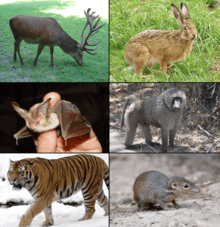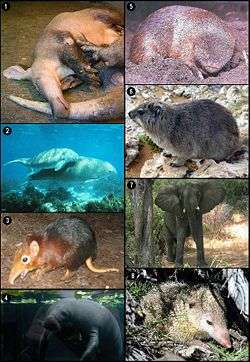Epitheria
Epitherians comprise all the placental mammals except the Xenarthra. They are primarily characterized by having a stirrup-shaped stapes in the middle ear, which allows for passage of a blood vessel. This is in contrast to the column-shaped stapes found in marsupials, monotremes, and xenarthrans. They are also characterized by having a shorter fibula relative to the tibia.
| Epitheria Temporal range: Late Cretaceous - Recent | |
|---|---|
 | |
 | |
| Scientific classification | |
| Kingdom: | Animalia |
| Phylum: | Chordata |
| Class: | Mammalia |
| Clade: | Eutheria |
| Infraclass: | Placentalia |
| Clade: | Epitheria |
| Orders and Clades | |
| |
Epitheria — like Xenarthra and Afrotheria — originated after the K-Pg boundary 66 million years ago, with the placental diversification occurring within the first hundred thousand years after the K-Pg event and the first modern placental orders began appearing 2–3 million years later.[1] Epitheres are one of the most successful groups of animals.
The monophyly of Epitheria has been challenged by molecular phylogenetic studies.[2] While preliminary analysis of a set of retroposons shared by both Afrotheria, and Boreoeutheria (presence/absence data) supported the Epitheria clade,[3] more extensive analysis of such transposable element insertions around the time of the divergence of Xenarthra, Afrotheria, and Boreoeutheria strongly support the hypothesis of a near-concomitant origin (trifurcation) of these three superorders of mammals.[4][5]
Another analysis suggests that the root of this clade lies between the Atlantogenata and Boreoeutheria.[6]
| Placentalia |
| ||||||||||||||||||
Alternative hypotheses
Alternative hypotheses place either Atlantogenata and Boreoeutheria, or Afrotheria and Exafroplacentalia (Notolegia) at the base of the tree:
| Placentalia |
| ||||||||||||||||||
| Placentalia |
| ||||||||||||||||||
One Bayesian analysis places the root between Atlantogenata and Boreoeutheria.[7]
References
- O'Leary, M. A.; Bloch, J. I.; Flynn, J. J.; Gaudin, T. J.; Giallombardo, A.; Giannini, N. P.; Goldberg, S. L.; Kraatz, B. P.; Luo, Z.-X.; Meng, J.; Ni, X.; Novacek, M. J.; Perini, F. A.; Randall, Z. S.; Rougier, G. W.; Sargis, E. J.; Silcox, M. T.; Simmons, N. B.; Spaulding, M.; Velazco, P. M.; Weksler, M.; Wible, J. R.; Cirranello, A. L. (2013). "The Placental Mammal Ancestor and the Post-K-Pg Radiation of Placentals". Science. 339 (6120): 662–667. doi:10.1126/science.1229237. ISSN 0036-8075. PMID 23393258. S2CID 206544776.
- For example: Springer, Mark S., Michael J. Stanhope, Ole Madsen, and Wilfried W. de Jong. 2004. Molecules consolidate the placental mammal tree" Trends in Ecology and Evolution 19:430–438.
- Kriegs, Jan Ole, Gennady Churakov, Martin Kiefmann, Ursula Jordan, Juergen Brosius, and Juergen Schmitz. (2006) Retroposed Elements as archives for the evolutionary history of placental mammals" PLoS Biol 4(4) e91.
- Nishihara, H., Maruyama, S. & Okada, N. 2009. Retroposon analysis and recent geological data suggest near-simultaneous divergence of these three superorders of mammals. PNAS 106: 5235-40.
- Churakov, G., Kriegs, J.O., Baertsch, R., Zemann, A., Brosius, J. & Schmitz, J. 2009. Mosaic retroposon insertion patterns in placental mammals. Genome Research 19: 868-75.
- Song S, Liu L, Edwards SV, Wu S (2012) Resolving conflict in eutherian mammal phylogeny using phylogenomics and the multispecies coalescent model. Proc Natl Acad Sci USA
- Morgan, CC; Foster, PG; Webb, AE; Pisani, D; McInerney, JO; O'Connell, MJ (2013). "Heterogeneous models place the root of the placental mammal phylogeny". Mol Biol Evol. 30 (9): 2145–256. doi:10.1093/molbev/mst117. PMC 3748356. PMID 23813979.
External links
- Summary of molecular support for Epitheria
- Waddell PJ, Kishino H, Ota R. 2001. A phylogenetic foundation for comparative mammalian genomics. Genome Inform Ser Workshop Genome Inform 12: 141–154
- Mark S. Springer, William J. Murphy, Eduardo Eizirik, and Stephen J. O'Brien (Edited by Morris Goodman). 2002 Placental mammal diversification and the Cretaceous-Tertiary boundary
- Wildman D.E.; Chen C.; Erez O.; Grossman L.I.; Goodman M.; Romero R. 2006. Evolution of the mammalian placenta revealed by phylogenetic analysis" PNAS 103 (9) 3203–3208
- Nikolaev, S., Montoya-Burgos, J.I., Margulies, E.H., Rougemont, J., Nyffeler, B., Antonarakis, S.E. 2007. Early history of mammals is elucidated with the ENCODE multiple species sequencing data" PLoS Genet 3:e2, doi:10.1371/journal.pgen.0030002.
- Gennady Churakov, Jan Ole Kriegs, Robert Baertsch, Anja Zemann, Jürgen Brosius, Jürgen Schmitz. 2008. Mosaic retroposon insertion patterns in placental mammals